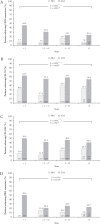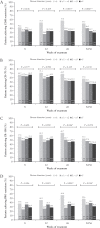Efficacy and Safety of Adalimumab by Disease Duration: Analysis of Pooled Data From Crohn's Disease Studies
- PMID: 30753371
- PMCID: PMC6535500
- DOI: 10.1093/ecco-jcc/jjy223
Efficacy and Safety of Adalimumab by Disease Duration: Analysis of Pooled Data From Crohn's Disease Studies
Abstract
Background and aims: Analyses of Crohn's Disease [CD] studies of anti-TNF agents, including adalimumab, have reported higher remission rates among patients with shorter disease duration. To further explore the relationship between disease duration and clinical efficacy, we analysed a larger patient cohort.
Methods: Data were pooled from 10 clinical trials in patients with moderately to severely active CD who received treatment with either adalimumab or placebo. Analyses of efficacy using Crohn's Disease Activity Index [CDAI] endpoints [remission, clinical response [CR]-70, CR-100, patient-reported outcome [PRO] remission] or Harvey-Bradshaw Index [HBI] endpoints [remission/response] were conducted for induction and maintenance treatment periods. Logistic regression was used for comparisons between adalimumab and placebo treatment. Cochran-Armitage trend tests were used for comparisons between disease-duration subgroups [<1 year, ≥1-<2 years, 2-≤5 years, and >5 years].
Results: During induction, the proportion of patients achieving CDAI remission was higher in adalimumab- versus placebo-treated patients [p <0.001] and was highest [adalimumab: 45.8%] in the <1 year subgroup compared with longer disease-duration subgroups [≥1-<2 years: 31.0%; 2-≤5 years: 23.1%; >5 years: 23.6%, Cochran-Armitage p = 0.026]. In the majority of maintenance treatment analyses, patients with <1 year disease duration had the highest efficacy responses, with statistically significant differences in remission rates across disease-duration subgroups.
Conclusions: This analysis demonstrates that earlier initiation of adalimumab treatment shortly after diagnosis in patients with moderately to severely active CD leads to improved long-term clinical outcomes.
Keywords: Adalimumab; Crohn’s disease; disease duration.
© European Crohn’s and Colitis Organisation (ECCO) 2019.
Figures



Similar articles
-
Subgroup analysis of the placebo-controlled CHARM trial: increased remission rates through 3 years for adalimumab-treated patients with early Crohn's disease.J Crohns Colitis. 2013 Apr;7(3):213-21. doi: 10.1016/j.crohns.2012.05.015. Epub 2012 Jun 16. J Crohns Colitis. 2013. PMID: 22704916 Clinical Trial.
-
Efficacy and safety of adalimumab in Canadian patients with moderate to severe Crohn's disease: results of the Adalimumab in Canadian SubjeCts with ModErate to Severe Crohn's DiseaSe (ACCESS) trial.Can J Gastroenterol. 2011 Aug;25(8):419-25. doi: 10.1155/2011/724813. Can J Gastroenterol. 2011. PMID: 21912766 Free PMC article. Clinical Trial.
-
Adalimumab Effectiveness Up to Six Years in Adalimumab-naïve Patients with Crohn's Disease: Results of the PYRAMID Registry.Inflamm Bowel Dis. 2019 Aug 20;25(9):1522-1531. doi: 10.1093/ibd/izz008. Inflamm Bowel Dis. 2019. PMID: 30753510 Free PMC article.
-
[Anti-TNF therapy in treatment of luminal Crohn's disease].Acta Med Croatica. 2013 Apr;67(2):179-89. Acta Med Croatica. 2013. PMID: 24471301 Review. Croatian.
-
Certolizumab pegol for the management of Crohn's disease in adults.Clin Ther. 2009 Jun;31(6):1158-76. doi: 10.1016/j.clinthera.2009.06.015. Clin Ther. 2009. PMID: 19695385 Review.
Cited by
-
Surgery versus Medical Therapy in Luminal Ileocecal Crohn's Disease.Clin Colon Rectal Surg. 2022 Jan 17;35(1):72-77. doi: 10.1055/s-0041-1740031. eCollection 2022 Jan. Clin Colon Rectal Surg. 2022. PMID: 35069033 Free PMC article. Review.
-
High refill-adherence to adalimumab is associated with low disease activity in patients with inflammatory bowel disease.Eur J Clin Pharmacol. 2024 Jul;80(7):1089-1096. doi: 10.1007/s00228-024-03676-8. Epub 2024 Mar 30. Eur J Clin Pharmacol. 2024. PMID: 38553558
-
The Impact of Intestinal Complications on Health Care Costs Among Patients With Inflammatory Bowel Disease Treated With Anti-Tumor Necrosis Factor Therapies.Inflamm Bowel Dis. 2021 Jul 27;27(8):1201-1209. doi: 10.1093/ibd/izaa270. Inflamm Bowel Dis. 2021. PMID: 33107564 Free PMC article.
-
Predictors and optimal management of tumor necrosis factor antagonist nonresponse in inflammatory bowel disease: A literature review.World J Gastroenterol. 2023 Aug 7;29(29):4481-4498. doi: 10.3748/wjg.v29.i29.4481. World J Gastroenterol. 2023. PMID: 37621757 Free PMC article. Review.
-
Early Intervention in Ulcerative Colitis: Ready for Prime Time?J Clin Med. 2020 Aug 14;9(8):2646. doi: 10.3390/jcm9082646. J Clin Med. 2020. PMID: 32823997 Free PMC article. Review.
References
-
- Torres J, Mehandru S, Colombel JF, Peyrin-Biroulet L. Crohn’s disease. Lancet 2017;389:1741–55. - PubMed
-
- Colombel JF, Narula N, Peyrin-Biroulet L. Management strategies to improve outcomes of patients with inflammatory bowel diseases. Gastroenterology 2017;152:351–61.e5. - PubMed
-
- Gomollón F, Dignass A, Annese V, et al. ; ECCO. Third European evidence-based consensus on the diagnosis and management of Crohn’s disease 2016. Part 1: diagnosis and medical management. J Crohns Colitis 2017;11:3–25. - PubMed
-
- Hazlewood GS, Rezaie A, Borman M, et al. . Comparative effectiveness of immunosuppressants and biologics for inducing and maintaining remission in Crohn’s disease: a network meta-analysis. Gastroenterology 2015;148:344–54.e5. - PubMed
MeSH terms
Substances
LinkOut - more resources
Full Text Sources
Medical

